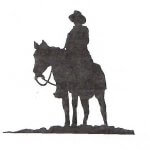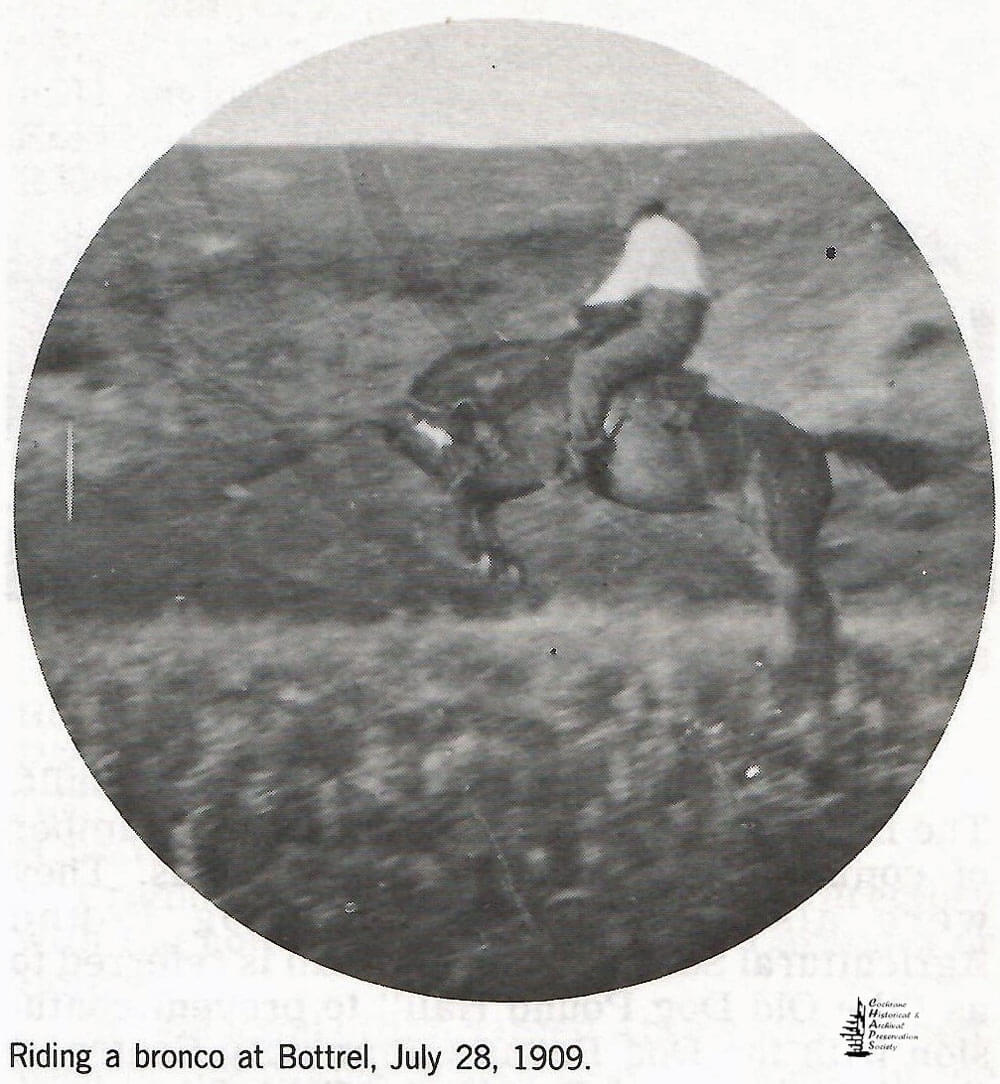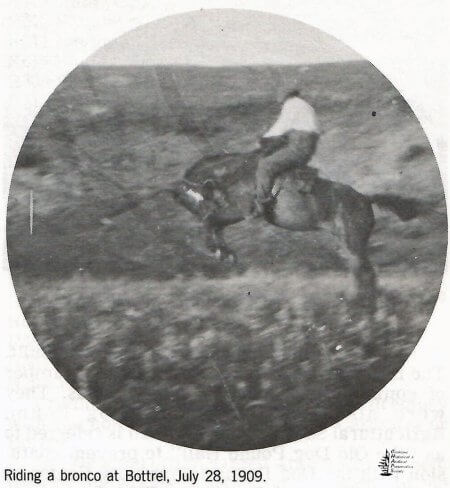-- by Dorothy J. Shand pg 426 Big Hill Country 1977
In the early 1900s, the Dog Pound Stampede or Rodeo began as a 24th of May Sunday School picnic, which was held on the flat land of the Botterell Ranch, close by the present Bottrel store. People in the surrounding area soon became very interested in visiting with their neighbours and enjoying the many events associated with horse racing and exhibition bucking horse riding, which were added to the usual foot races, jumping and games. Attendance was either on foot, horseback, or horse-drawn vehicles.
A few years after Bottrel Store and Post Office opened, the location of the picnic was moved to the Charlie Chouinard ranch located on the NE 14 33-28-4-5. In 1912 this community event was held at the present Dog Pound Stampede grounds on the NE14 3-29-4-5.
In 1913 the Dog Pound Hall was built and used for community affairs of all descriptions. A judges stand, which was erected near the east end of the hall, was used until the early 1930s. There was a picnic shelter attached to the north side of the hall and though it was “open-air”, it had picnic tables, and food could be purchased and eaten there. A refreshment booth, which served ice cream, candy, lemonade, and many other things, was attached to the west end of the hall.
In the early years, the Dog Pound Picnic began at 11 a.m. and continued throughout the rest of the day and evening. Many people attend ing took a picnic lunch. Entry to the grounds was from the southeast corner up a steep hill.
Nearly every family was involved in the sports which included all types of foot races, jumping, tug-of-war and games which started the day and were followed by horse races, stampede events and a ball game in the evening. There was a race track that circled the top of the hill at the grounds. Some of the races which required skillful riding on horseback were: tilting at the ring, egg and spoon race, threading the needle and others too numerous to mention. Competition for prizes in all events was very keen.
Before corrals, chutes and an arena were built, bucking horses, which were wild horses unaccustomed to being handled, were snubbed to a saddle horn, blindfolded and saddled. The rider mounted, the blindfold was removed and rider and horse competed as they struggled with each other. Riders on trained horses were near in case of need or to pick the rider off if he was still on at the end of the ride.
The Indians [sic] were an attraction with their very intricately beaded buckskin costumes and wearing very flashy paint. Their colourful tents were erected on the grounds. They conducted Indian [sic] pow-wows, demonstrated their accuracy with bows and arrows and participated in many, if not all, events. Their descendants still compete in the stampede events but they no longer display their tents.
An announcer, using a megaphone, informed people about what was taking place.
More recently, an electric public address system, in the announcer’s stand above the chutes at the west end of the arena, allows the announcer to give information with clarity and ease.
In the very early years of the Dog Pound picnic, a platform was laid down for the open-air “jitney” dance which was held in the late evening. Tickets for the dance were bought at the ticket booth located near the platform, presented and collected upon entering the floor. A cement platform has replaced the original one, and, very recently, instead of buying individual tickets, a flat charge is made, a stamp placed on the hand, and the stamp shown upon entering to dance. The music has always been provided by a live orchestra.
The Dog Pound Hall became the property of the United Farmers of Alberta who had a very active locally in the area. They had title to the 40 acres which comprised the grounds, and though the U.F.A. didn’t interfere with the management of the hall they legally owned it. This building with its excellent dance floor had served the community well but it was in need of repair. The Busy Beavers, a very active club in the area, were considering the possibility of building a new hall to replace the original one and it was decided the land should belong to the community first. After a continued effort by the local stampede board, with the capable assistance of William Bagnall, Reeve of the County of Mountain View, the U.F.A. gave up the title to this land and building. To fulfill the required regulations a registered association had to be formed to accept the title, so the Dog Pound Agricultural Society was organized. In 1965 the title was transferred but the U.F.A. reserved the oil rights.
In 1967 the new Quonset type hall was built. The Busy Beavers Club had sponsored a number of community projects to obtain funds. They were also assisted by the Dog Pound Agricultural Society. This new hall is referred to as “the Old Dog Pound Hall” to prevent confusion with the Dog Pound Community Centre at the site which was Dog Pound School.
In the late 1930s, the foot races and horse races were discontinued and the event became a stampede or rodeo only, which was directed by the local stampede board and commenced at 1 p.m. It was, for as many years as can be remembered now, and still is, held in July. Formerly it was nearly always held the second Wednesday after the Calgary Stampede but recently it is sometimes the first Wednesday after.
For a number of recent years, the Dog Pound Stampede was affiliated with the Foothills Cowboy Association but has been an amateur show for the last two years. Beginning with a Grand Entry the events include saddle bronc riding bareback riding, calf roping, boys’ steer riding steer wrestling, bull riding, wild cow milking and a wild horse race. All must adhere to rules and regulations with judges and timekeepers busy. Pick up men on fast, trained horses do an excellent job as well as many helpers at the chutes and catch pens. Sometimes the prize money has to be split between contestants.
Upon completion of the stampede, there is a ball game between two local teams in the early evening, followed by the open-air dance which continues to draw crowds from near and far.
Concessions on the grounds featuring games of chance, booths serving refreshments, supplemented by meals served in the hall, are all part of the day. Entry to the grounds has been for many years at the southwest corner. Tickets are sold upon reaching the top of the entrance hill.
Excerpt from Wrigley's Alberta Directory - "Bottrel – 1920
Alberta Government Telephones long distance service –
William Bercov – Agent Rebecca Bercov – General store
William Bercov – Postmaster.” “Bottrel – 1928-29
A.G.T. phones – H. Pearson – agent Ed Arndt — Blacksmith Durward H. Blatchford — farmer William Houghton – trucker Wanda Huston — school teacher
Harry Pearson – General store, garage, A.G.T. phones and Postmaster
Patrick Spence — garage mechanic Frank Winchell – fox farm.” “Dog Pound – 1920
A Post Office – Section 3-29-4-5. Cochrane Provincial Electoral Division. Reached by bi weekly stage from Cochrane on CPR 20 miles south. Atkins nine miles distant is nearest telephone office and has public school. Average value of land is $15. an acre – 40 farmers reside in area. Mixed farming – dairying and stock raising. A.G.T. long distance service. C. A. Grain
– Postmaster.” “Cochrane — 1890
Botterell – Proprietor Dog Pound Horse Ranch.”





